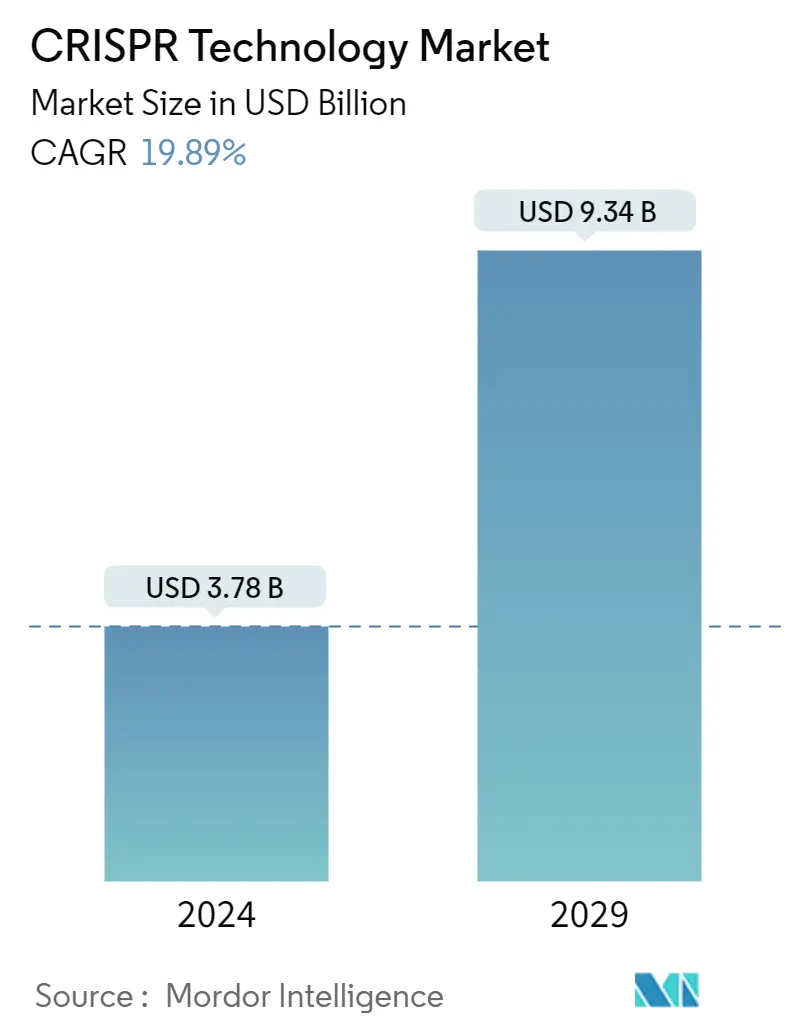Market Size of CRISPR Technology Industry

| Study Period | 2021 - 2029 |
| Market Size (2024) | USD 3.78 Billion |
| Market Size (2029) | USD 9.34 Billion |
| CAGR (2024 - 2029) | 19.89 % |
| Fastest Growing Market | Asia Pacific |
| Largest Market | North America |
| Market Concentration | Medium |
Major Players
*Disclaimer: Major Players sorted in no particular order |
CRISPR Technology Market Analysis
The CRISPR Technology Market size is estimated at USD 3.78 billion in 2024, and is expected to reach USD 9.34 billion by 2029, growing at a CAGR of 19.89% during the forecast period (2024-2029).
Factors driving the global market's growth include increasing government and private funding, rising demand for and adoption of CRISPR, and technological advancements.
The growing funding and support activities by the government and private entities, along with the launch of various research projects and programs, are expected to advance CRISPR technology over time. This substantial financial backing is anticipated to enhance the market prospects for CRISPR technology. For instance, in July 2023, Pfizer invested USD 25 million in Caribou Sciences, giving the company a boost of funding for an experimental multiple myeloma treatment. The investment agreement directs Caribou to use the funds to advance CB-011. This CRISPR-edited allogeneic CAR T-cell therapy is currently in Phase 1 testing for patients with relapsed or refractory multiple myeloma.
There has also been a rise in research projects and program grants in the CRISPR domain. For instance, in October 2023, Yale School of Medicine received a grant of USD 40 million from the National Institutes of Health (NIH) for its research on developing a CRISPR gene-editing platform technology capable of reaching the human brain. The innovative new genome-editing technology could lead to treatments or cures for many neurogenetic diseases. Such funding for market players and grants from national institutes are expected to help boost the CRISPR technology market over the forecast period.
Additionally, CRISPR technology advances genome editing across the fields of medicine, biotechnology, and agriculture, enabling scientists to conduct research through faster and more efficient genome editing. For instance, according to a report published by Nature Publications in November 2022, CRISPR gene editing can alter patients' immune cells (T cells) to recognize disease-causing proteins expressed in solid tumors. This work builds on research on genome editing to redirect T cell specificity with transgenic TCR engineering. Thus, owing to its easy, quick, and inexpensive access to vectors and the resulting next-generation tools, the demand for CRISPR technology is expected to increase over the forecast period.
CRISPR-Cas9 works by precisely editing the DNA within cells, allowing researchers to correct genetic mutations associated with inherited eye diseases, neurodegenerative conditions like Alzheimer's and Huntington's, and even non-inherited diseases such as cancer and HIV. By targeting and modifying specific genes implicated in these diseases, CRISPR holds promise for potentially treating or preventing diseases at their genetic roots. For instance, according to the study published by Springer Nature in March 2023, the rapid development of CRISPR-based genome editing technology emphasizes the expansion of the CRISPR-Cas toolbox with novel Cas orthologs, engineered variants, and transposon-associated programmable RNA-guided systems.
The abovementioned report also discussed the potential applications of CRISPR-Cas systems in precise genome editing, such as base editing and prime editing, and their revolutionary impact on cardiovascular research. CRISPR-Cas systems have been demonstrated in creating genetically modified in vitro and animal models of cardiovascular diseases, which offer valuable insights into the genetic basis of cardiovascular conditions and potential avenues for therapeutic interventions. Thus, the market studied is projected to record growth over the forecast period in line with increasing government and private funding, rising demand for and adoption of CRISPR, and technological advancements. However, the high costs of CRISPR and ethical concerns related to genetic research are restraining the growth of the market.
CRISPR Technology Industry Segmentation
As per the scope of the report, CRISPR technology is a tool for editing genomes. It enables researchers to alter DNA sequences and further modify gene function easily. It has several potential applications, including treating and preventing disease spread, correcting genetic defects, and improving crops.
The CRISPR technology market is segmented by product, application, end user, and geography. The product segment is further segmented into enzymes, kits, and reagents, guide RNA, and other products. The application segment is further divided into biomedical, agricultural, industrial, and other applications. The end user segment is further bifurcated into pharmaceutical companies and biotechnology companies, academics and government research institutes, and other end users (CROs, etc.). By geography, the market is further segmented into North America, Europe, Asia-Pacific, Middle East And Africa, and South America. The report offers the value (in USD) for the segments mentioned above.
| By Product | |
| Enzymes | |
| Kits and Reagents | |
| Guide RNA | |
| Other Products |
| By Application | |
| Biomedical | |
| Agricultural | |
| Industrial | |
| Other Applications |
| By End User | |
| Pharmaceutical Companies and Biotechnology Companies | |
| Academics and Government Research Institutes | |
| Other End Users |
| By Geography | ||||||||
| ||||||||
| ||||||||
| ||||||||
| ||||||||
|
CRISPR Technology Market Size Summary
The CRISPR technology market is poised for significant growth, driven by increasing government and private funding, rising demand, and technological advancements. The market is expected to expand substantially over the forecast period, with substantial financial backing from both public and private sectors enhancing its prospects. This growth is further supported by numerous research projects and grants, such as those from the National Institutes of Health, which are advancing CRISPR technology's capabilities. The technology's application across medicine, biotechnology, and agriculture is facilitating faster and more efficient genome editing, promising potential treatments for various diseases by targeting and modifying specific genes. Despite the high costs and ethical concerns associated with genetic research, the demand for CRISPR technology is anticipated to rise, particularly in biomedical applications, where it is increasingly used for genome engineering, disease model studies, and functional genomics.
In North America, the CRISPR technology market is expected to experience significant growth due to technological innovations, product approvals, and strategic initiatives by key market players. Companies are actively investing in research and production facilities to meet the rising demand for CRISPR technologies, with major players like Synthego Corporation and Sherlock Biosciences leading the charge through strategic partnerships and acquisitions. The market's competitive landscape is characterized by a moderate level of fragmentation, with significant contributions from companies such as ThermoFisher Scientific Inc., Merck KGaA, and GenScript. The focus on personalized medicine and co-development activities, along with regulatory approvals for CRISPR-based therapies, is expected to further drive market growth and innovation.
CRISPR Technology Market Size - Table of Contents
-
1. MARKET DYNAMICS
-
1.1 Market Overview
-
1.2 Market Drivers
-
1.2.1 Increasing Government and Private Funding
-
1.2.2 Rising Demand and Adoption of CRISPR
-
1.2.3 Technological Advancements
-
-
1.3 Market Restraints
-
1.3.1 High Costs of Using CRISPR
-
1.3.2 Ethical Concerns Related to Genetic Research
-
-
1.4 Porter's Five Forces Analysis
-
1.4.1 Threat of New Entrants
-
1.4.2 Bargaining Power of Buyers/Consumers
-
1.4.3 Bargaining Power of Suppliers
-
1.4.4 Threat of Substitute Products
-
1.4.5 Intensity of Competitive Rivalry
-
-
-
2. MARKET SEGMENTATION (Market Size by Value - USD)
-
2.1 By Product
-
2.1.1 Enzymes
-
2.1.2 Kits and Reagents
-
2.1.3 Guide RNA
-
2.1.4 Other Products
-
-
2.2 By Application
-
2.2.1 Biomedical
-
2.2.2 Agricultural
-
2.2.3 Industrial
-
2.2.4 Other Applications
-
-
2.3 By End User
-
2.3.1 Pharmaceutical Companies and Biotechnology Companies
-
2.3.2 Academics and Government Research Institutes
-
2.3.3 Other End Users
-
-
2.4 By Geography
-
2.4.1 North America
-
2.4.1.1 United States
-
2.4.1.2 Canada
-
2.4.1.3 Mexico
-
-
2.4.2 Europe
-
2.4.2.1 Germany
-
2.4.2.2 United Kingdom
-
2.4.2.3 France
-
2.4.2.4 Italy
-
2.4.2.5 Spain
-
2.4.2.6 Rest of Europe
-
-
2.4.3 Asia-Pacific
-
2.4.3.1 China
-
2.4.3.2 Japan
-
2.4.3.3 India
-
2.4.3.4 Australia
-
2.4.3.5 South korea
-
2.4.3.6 Rest of Asia-Pacific
-
-
2.4.4 Middle East and Africa
-
2.4.4.1 GCC
-
2.4.4.2 South Africa
-
2.4.4.3 Rest of Middle East and Africa
-
-
2.4.5 South America
-
2.4.5.1 Brazil
-
2.4.5.2 Argentina
-
2.4.5.3 Rest of South America
-
-
-
CRISPR Technology Market Size FAQs
How big is the CRISPR Technology Market?
The CRISPR Technology Market size is expected to reach USD 3.78 billion in 2024 and grow at a CAGR of 19.89% to reach USD 9.34 billion by 2029.
What is the current CRISPR Technology Market size?
In 2024, the CRISPR Technology Market size is expected to reach USD 3.78 billion.

